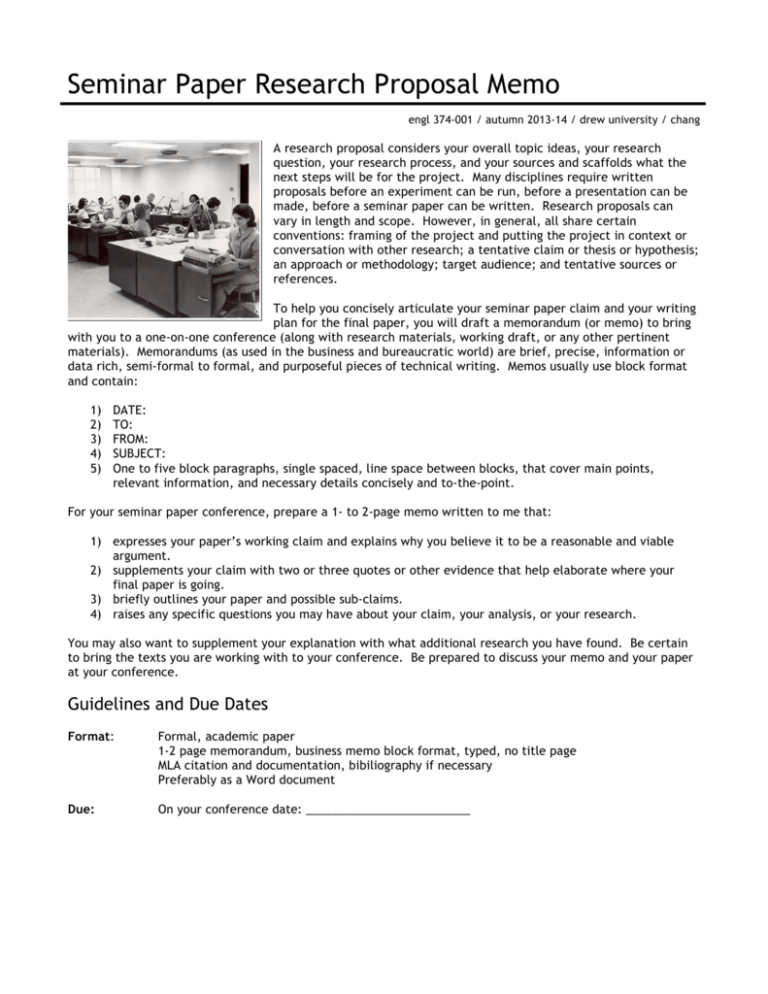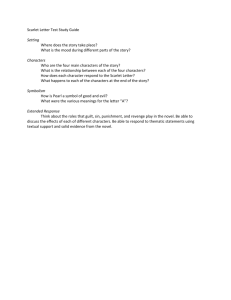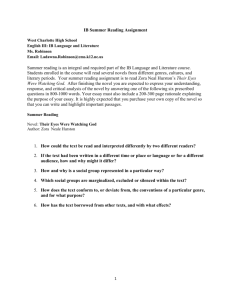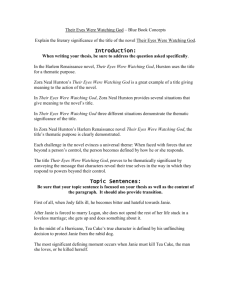Research Proposal Memo
advertisement

Seminar Paper Research Proposal Memo engl 374-001 / autumn 2013-14 / drew university / chang A research proposal considers your overall topic ideas, your research question, your research process, and your sources and scaffolds what the next steps will be for the project. Many disciplines require written proposals before an experiment can be run, before a presentation can be made, before a seminar paper can be written. Research proposals can vary in length and scope. However, in general, all share certain conventions: framing of the project and putting the project in context or conversation with other research; a tentative claim or thesis or hypothesis; an approach or methodology; target audience; and tentative sources or references. To help you concisely articulate your seminar paper claim and your writing plan for the final paper, you will draft a memorandum (or memo) to bring with you to a one-on-one conference (along with research materials, working draft, or any other pertinent materials). Memorandums (as used in the business and bureaucratic world) are brief, precise, information or data rich, semi-formal to formal, and purposeful pieces of technical writing. Memos usually use block format and contain: 1) 2) 3) 4) 5) DATE: TO: FROM: SUBJECT: One to five block paragraphs, single spaced, line space between blocks, that cover main points, relevant information, and necessary details concisely and to-the-point. For your seminar paper conference, prepare a 1- to 2-page memo written to me that: 1) expresses your paper’s working claim and explains why you believe it to be a reasonable and viable argument. 2) supplements your claim with two or three quotes or other evidence that help elaborate where your final paper is going. 3) briefly outlines your paper and possible sub-claims. 4) raises any specific questions you may have about your claim, your analysis, or your research. You may also want to supplement your explanation with what additional research you have found. Be certain to bring the texts you are working with to your conference. Be prepared to discuss your memo and your paper at your conference. Guidelines and Due Dates Format: Formal, academic paper 1-2 page memorandum, business memo block format, typed, no title page MLA citation and documentation, bibiliography if necessary Preferably as a Word document Due: On your conference date: _________________________ Sample Research Proposal Memo engl 374-001 / autumn 2013-14 / drew university / chang For example, the following is a one-page seminar paper proposal for a literature class (in memo format): DATE: TO: FROM: SUBJECT: July 13, 2001 Dr. Norman EH 540 Michelle V. Paper Proposal: ‘You Looks Like Youse Yo’ Own Daughter’: Figuring (In)fertility and Maternity in Their Eyes Were Watching God Although critical responses to Hurston’s Their Eyes Were Watching God have focused extensively on both sexuality and images of fecundity in the text, analyses that fully address fertility and maternity in the novel are as strangely absent from the critical literature as the presumable fact of Janie’s reproductive capacity is from the text itself. Unlike Nella Larsen’s roughly contemporary novel Quicksand, Hurston not only seems to deny the notion that marriage is death for women, she also disrupts the traditional association of marriage with pregnancy/childbirth (McDowell xxi). It is unclear whether Hurston took this non-approach to Janie’s fertility in the novel as a means of disequating marriage and childbirth, or simply because pregnancy and maternity did not figure in the story she wanted to tell. However, the novel’s emphasis on fertility in nature and sexuality renders this textual absence particularly problematic. The proposed paper will begin with an examination of the ample fertility imagery in the novel. Janie’s early conflation of fertility in nature, sexual desire, and marriage will be discussed, followed by the role that sexuality plays in each of her marriages. Then, the textual absence of Janie’s reproductive fertility will be addressed, as well as a discussion of whether this textual absence is evidence of the novel’s failed realism, as some critics have suggested, or a byproduct of the idealization of the world of the novel. A short discussion of the trope of textual absence or elision of conception and pregnancy in the works of several African American women writers will also be included. Although I have not yet fully formulated the theoretical framework I will use to account for the problematic treatment of Janie’s fertility in the novel, the textual elements that I am planning to discuss will be the extended mule metaphor/imagery (with its implications of sterility) and the depiction of other maternal relationships in the novel (particularly those of Nanny and Leafy to both each other and to Janie). Finally, I will relate the treatment of maternity and fertility in the novel with the overarching theme of Janie’s quest for fulfillment/selfhood/voice/independence/embodiment. Several extensive searches of the critical literature addressing Their Eyes have failed to reveal any full-length articles addressing the textual absence of Janie’s fertility. The articles listed below address various aspects of sexuality and sexual autonomy, marriage, and fertility imagery in the novel. —From http://www.uah.edu/aaww/sample_proposal_their_eyes.htm Here is another sample proposal (in memo format): DATE: TO: FROM: SUBJECT: [date] Professor Virginia Montecino [name and email address] [The subject is the broad topic] My rationale and why writing about this topic will be beneficial to me: [If you are not vested in your topic, chances are your incentive to write about the subject will be weak. If you are interested in the topic you will probably write a better paper.] My claim or argumentative thesis: [ The thesis is generally a sentence or two, which comes after the introductory material and states the main point/s in your paper. It is NOT a question. If your subject is fertility treatments, for example, your thesis might be "The high number of multiple births is forcing society to examine the ethical issues that are caused by fertility drugs and invitro fertilization. ] Approach to the subject of my paper: [Try to envision a logical way in which to present your material. In what order will you present your material to best address the issues? Will you have to define any terms? If so, which ones? Will you have to clarify terms and concepts? Do you think that inserting anecdotal evidence, for example, high profile stories of people who have had multiple births, as in the case above, will help your reader understand your paper? Will you show opposing viewpoints? Will you discuss the plusses and minuses of different platforms that perform similar functions? Will you be comparing and contrasting? Will you be categorizing some information? Perhaps you will be using a number of these approaches in your paper. Let me know where you think you are headed.] Intended audience: [Your readers should not be specialists in your field. Assume that your readers have, in general, your level of education, but are not necessarily majoring in the same subject. You will have to define terms and explain concepts. But beyond these obvious ground rules, discuss what people or group of people might benefit from reading your paper. For example, in the multiple birth example, might prospective users of fertility clinics, childless husbands and wives, benefit from the information in your paper? ] Kinds of sources I will use and why they will benefit my paper: [Do you have a balanced variety of sources? What strengths will they lend to the paper? How will they help clarify points you want to make? Use a combination of sources. Do not use all Internet sources. Some of your sources must be from a professional journal in your field, such as a nursing journal, a computer science or engineering journal, such as IEEE Spectrum. Some high end general audience publications such as Scientific American, or PC Computing can be used. Internet sources can be used if they are from credible sites such as the National Institute of Health, The Association for Computing Machinery (ACM). See a list of Internet resources by discipline (http://mason.gmu.edu/~montecin/disciplines.htm) and do your own searches for other resources.] Tentative List of References: [You should have at least eight (8) separate sources listed in the proper MLA format. This information should be on a separate page called References. Abide by all of the MLA format guidelines for the reference page. The sources should be varied -- not all Internet sources, for example -- and be appropriate for a college level research paper. People magazine, Readers Digest, and others of that ilk are not satisfactory. Show me that you know how to find and can analyze data from sources within your discipline. Your final reference page in the Research Paper should have a minimum of 8 to 10 sources, each of which must be used as a source in your paper. Do not put any sources in your references that you have not used in your paper. It is possible for some of your sources to change as you become more deeply involved in writing your paper. Advise me of changes in references. ] —Adapted from http://mason.gmu.edu/~montecin/res-pap-pro.html#proposal







